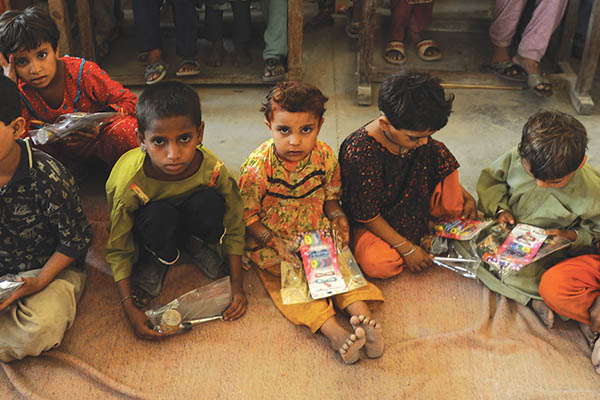
Internally displaced children in Pakistan receive Eidul Fitr packages at a camp in Sukkur. Adek Berry—AFP
Holding a primary textbook, probably for the first time, in his tiny sore-ridden hands, 10-year-old Mansoor shuffled uneasily to find room on a cramped wooden bench. He is one of 48 boys and girls squeezed into a room that can barely hold 30 at a camp school set up by the National Commission for Human Development for flood-affected children in the southern Pakistani city of Sukkur.
After the worst natural disaster in the country’s history, such temporary educational facilities or learning centers (TLCs), run by various government and nongovernment organizations, are trying to provide schooling to the afflicted with whatever resources are available. As of Sept. 14, these learning centers cater to 32,250 children nationwide. With educational infrastructure destroyed, shortages of personnel, and many no longer able to afford education, protracted periods of interrupted schooling are bound to have harsh long-term consequences for millions of children.
While the full damage assessment is not complete, what we do know so far is staggering. Of the 20 million affected, half are children. According to the U.N.’s Office for the Coordination of Humanitarian Affairs, floodwaters have damaged 8,618 educational facilities. Furthermore, about 5,700 schools that did survive the deluge are being used as temporary shelter for 1.5 million flood victims. In many areas, the furniture from schools is being used as fuel.
But amid these overwhelming numbers, there is hope—and an opportunity—to not just rebuild, but to also completely revamp the education system. By mid-August, recognizing the post-flood implications, planners in Islamabad and major policy centers elsewhere shifted from compassion to thinking in real terms about recovery, reconstruction, and rehabilitation. For them, this is a chance to act—not just to cope with short-term challenges, but to ensure a lasting recovery in the long run.
Innovation in the near term can happen while normal school reconstruction is underway. Schools and TLCs can be the starting point for the provision of essential support, such as social protection, nutrition, water, sanitation, and health services. But these immediate needs require better management, efficient utilization of resources, sustainable interventions, coordination among agencies, and higher levels of spending. How this is done need not be based on past performance: remarkable reactions have been witnessed when nations are faced with overwhelming challenges. Today we are witnessing a wave of volunteerism and humanitarian spirit from the Pakistani people. Consider the medical students from Karachi and Lahore who are setting up temporary schools for children in the flood-hit zones.
In coming years, Pakistan’s already lagging primary-school enrollment and completion rates are facing greater threat after the floods. The literacy rate, too, was already well short of the Millennium Development Goals target of 88 percent by 2015, with marginal increases to 57 percent in 2008-09. The rate of increase needs to more than double for the targets to be achieved, a task made even harder by the floods.
Pakistan will be at peril if we do not respond to this challenge. Given the scale, rehabilitation may stretch over three to five years, where interventions will need to target up to 7 million flood-affected children between the ages of 3 and 15, approximately one third of the total population of that age group in Pakistan.
At the Millennium Development Goals summit that kicks off Sept. 20 in New York, Pakistan plans to explain its current status on the MDGs to the world community, but the ultimate measure will be the commitment of Pakistan’s leadership. A June 2010 report on Pakistan’s education system by the Brookings Institution pointed out that low enrolment rates in the country cannot just be blamed on rising poverty, high opportunity costs, and negative stereotypes. Rather, it points to the government’s inability to provide high-quality education.
In rebuilding the future of Pakistan, simple reconstruction of physical infrastructure will not do. The challenge before planners is the renewal of social capital. There is a genuine opportunity now to create a new matrix of social and economic relationships between citizens and the state.
Young Mansoor’s hopes, and those of millions of other children, are pinned on the present democratic dispensation led by the Pakistan Peoples Party, which espouses a progressive social agenda. It must keep its promises.
Ali is a member of Parliament and an adviser to the prime minister.
